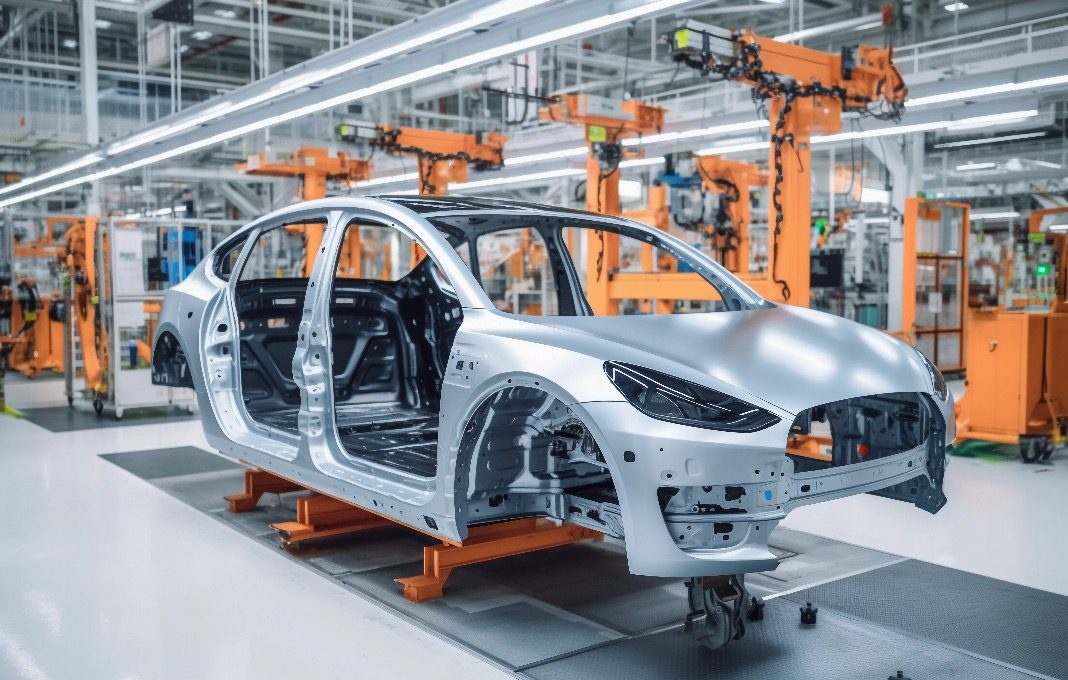What Are Auto Suppliers Supposed To Do As EV ‘Revolution’ Stalls?


The dilemma is as new as today’s headlines, and maybe as wrenching as anything they’ve ever had to go through: What are automotive suppliers to make of — and do about — the clear slowdown of the industry’s march into all-electric vehicles? Many have already committed massive resources and laid huge future plans based on the “revolution” going smoothly.
For many chiefs of car-component makers from Tier One all the way down through Tier Four, the future of their company may depend on how they answer.
Consider two fresh headlines from Automotive News on Thursday: “American Axle transitions into power source supplier” and “Hertz to sell 20,000 EVs in shift back to gasoline-powered cars.”
Put the two stories together, and manufacturing chiefs can see that one of the industry’s most significant Tier One suppliers, a former unit of General Motors, is betting everything on making an expensive transition to supplying drivetrain components for EVs instead of internal-combustion vehicles, at the same time that one of the biggest purchasers of fleet vehicles is responding to customer reluctance about the technology by swinging back to the comfort of gasoline-powered rentals.
Supplier chiefs are feeling whipsawed, and rightfully so. “Manufacturers that are supplying parts for EVs are expecting certain amounts of volume, have built business cases, have brought a bunch of new capital to bear, and many have agreed to loss-making or lower margins on some of these in order to be in first-mover position,” said Dan Hearsch, Americas leader of the automotive and industrial practice for AlixPartners consultants.
From the multi-billion-dollar Tier Ones that are essentially peers of the original-equipment manufacturers of autos, down through the Tier Four suppliers that run mom-and-pop machine shops in suburban Detroit, the clear lack of consumer enthusiasm for all-electric vehicles — which has translated into OEMs slowing down and stretching out their transitions to EVs — is an arresting development.
Most analysts agree that the growing hesitation by vehicle purchasers is more related to their concerns about charging infrastructure and practices than it is to the merits of EV models per se. Dozens of new EVs and hybrids have come out that are very drivable, even fun; are comfortable, with innovations in interior spaces that have been freed up by the battery-propulsion architecture of the vehicles; and are providing increasing ranges, as high as 300 miles on a charge, that assuage much of the “range anxiety” consumers may feel.
But where, when, how and how fast consumers can recharge their EVs has become a hindering consideration, even as everyone from a coalition of OEMs to the federal government to state transportation departments to major retailers and hotel chains have been building out EV chargers by the thousands.
In fact, Hearsch said, the distant future of EVs may be undimmed — which also makes decisions difficult for supplier chiefs. “I don’t see this [period as indicating], ‘Oh my gosh, people aren’t going to buy EVs.’ I think the push was more aggressive than what consumers were ready for because the charging infrastructure isn’t there yet. But the long-term EV outlook hasn’t changed.”
Joseph McCabe, president and CEO of AutoForecast Solutions, an industry advisory firm, said “the hard part about forecasting EV demand is: When does the new-adopter apex hit? It has come. And now sales have slowed. And what is happening is that suppliers are still being told to come up with obnoxiously large volumes when the reality is that the market is definitely [sliding] back.”
Auto suppliers, of course, are used to being caught in such pincers. For decades, OEMs have pounded them regularly for price concessions, wielding an existential sledgehammer. More recently, automakers pressured suppliers to devote more resources to product and feature innovations to improve future vehicles. And the pandemic introduced a three-year period of fresh frustrations of supply-chain snarls related to microchip supplies that clashed with decades of industry efforts to create just-in-time inventory systems.
In light of all of this, here are some ideas for suppliers to navigate the rising uncertainties of the EV era:
• Buttonhole your customers. Suppliers need to ensure that their customers are going to provide them financial cover to make major new investments in EV-related products regardless of how quickly they’re actually taken up in new vehicles and in volume. Requests may range from tightening up payment windows to volume guarantees.
“Suppliers will have to cut costs or go to OEMs and say, ‘I tooled up for 100,000 orders, but if you only want 50,000, you’re going to have to write me a check,” Hearsch said. “OEMs have learned it’s a lot less expensive to support suppliers like this rather than let them go bankrupt. However, there’s a limit to what they’re going to do, and they’re not going to help everyone.”
Added McCabe: “Suppliers aren’t going to be standing at the line saying, ‘Hell, no,’ but they’ve got to have a conversation. If [OEMs] want to have a long-term relationship, suppliers have to find a way not to lose money. In some cases, they’re publicly traded.”
These negotiations also must occur lower down in the supply chain where, for instance, a Tier Two supplier of castings may be much larger than the Tier One company to which it is supplying the transmissions that ultimately go to the automakers.
• Don’t go in unarmed. Discussions with OEMs aren’t necessarily a matter of only going hat in hand, either, because OEMs need suppliers to come up with innovations that can differentiate their vehicles from others as the new EV derby takes shape.
“Every manufacturer is looking for the next shiny object versus their competition, so suppliers do have more power in that regard,” McCabe said. “They’re relying on their supply chains to do that for them. They’re relying on their Tier 1 suppliers to bring their best games to the table. These suppliers are global in scale and can use European and Asian customer bases to offset what is happening” in the U.S. so far.
• Be cash-conservative. One of the biggest reasons suppliers are feeling so crunched these days is because the cost of financing their capital expenditures and inventories has risen so precipitously with interest rates. This has tied suppliers’ hands to some extent at the same time the move to EV production is calling for record investments in new products, equipment and plants.
“Many suppliers are down to bare bones,” Hearsch said. “Net debt is up. And then you take away their ability to generate revenues, while interest payments get higher – some companies will fail.”
In this environment, Hearsch said, “think about cash conservation” across the board. For example, “You’re not going to be buying [components] so far ahead, which is really hard. Because, what has the strategy become the last few years? They had to order semiconductors and metals much further ahead, secure them, and figure out ways to finance their supply chain so they didn’t run out of cash. So we are seeing more supply-chain financing programs from banks.”
• Redouble on execution. Hearsch advised suppliers to “do whatever you’re doing as lean as possible.”
One reason: Upward pressure on labor compensation has increased with the record financial settlements obtained last fall by the United Auto Workers with the Detroit Three automakers. With rising expenses for labor, for instance, “You need to be staffing appropriately,” Hearsch said. “Don’t waste any of that. It means achieving better first-time pass-through quality so you’re not throwing a lot of labor at redoing things.”
• Think about Toyota? Tesla has firmly established itself in the pole position of the U.S. EV market, but the market pecking order — and, therefore, sources of future demand — seems to be wide open after that.
“Tesla has figured out how to be the rock star,” McCabe said. “That’s a unicorn alert. Everyone else is fighting for second.”
And because that’s the case, McCabe suggested, supplier chiefs should carefully and objectively analyze the electrification business models being pursued by their OEM customers. Which ones seem to have the best strategies, including flexibility for responding to consumer demand as well as trying to create it?
From that perspective, for instance, Toyota’s emphasis on hybrid vehicles rather than all-electric models might make sense. “The industry is coming back and saying, ‘Maybe we need a more balanced portfolio,’” McCabe said. “Toyota is saying, ‘Let’s hybridize.’”


0

1:00 - 5:00 pm
Over 70% of Executives Surveyed Agree: Many Strategic Planning Efforts Lack Systematic Approach Tips for Enhancing Your Strategic Planning Process
Executives expressed frustration with their current strategic planning process. Issues include:
Steve Rutan and Denise Harrison have put together an afternoon workshop that will provide the tools you need to address these concerns. They have worked with hundreds of executives to develop a systematic approach that will enable your team to make better decisions during strategic planning. Steve and Denise will walk you through exercises for prioritizing your lists and steps that will reset and reinvigorate your process. This will be a hands-on workshop that will enable you to think about your business as you use the tools that are being presented. If you are ready for a Strategic Planning tune-up, select this workshop in your registration form. The additional fee of $695 will be added to your total.

2:00 - 5:00 pm
Female leaders face the same issues all leaders do, but they often face additional challenges too. In this peer session, we will facilitate a discussion of best practices and how to overcome common barriers to help women leaders be more effective within and outside their organizations.
Limited space available.

10:30 - 5:00 pm
General’s Retreat at Hermitage Golf Course
Sponsored by UBS
General’s Retreat, built in 1986 with architect Gary Roger Baird, has been voted the “Best Golf Course in Nashville” and is a “must play” when visiting the Nashville, Tennessee area. With the beautiful setting along the Cumberland River, golfers of all capabilities will thoroughly enjoy the golf, scenery and hospitality.
The golf outing fee includes transportation to and from the hotel, greens/cart fees, use of practice facilities, and boxed lunch. The bus will leave the hotel at 10:30 am for a noon shotgun start and return to the hotel after the cocktail reception following the completion of the round.